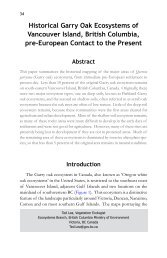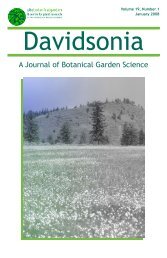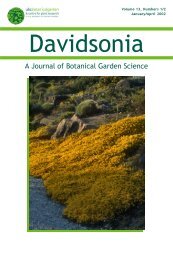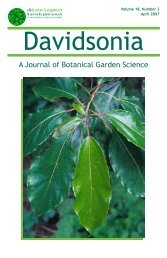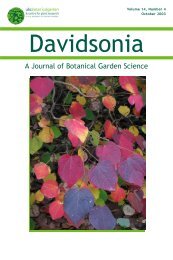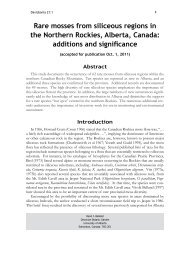Viscin Cells in the Dwarf Mistletoe Arceuthobium ... - Davidsonia
Viscin Cells in the Dwarf Mistletoe Arceuthobium ... - Davidsonia
Viscin Cells in the Dwarf Mistletoe Arceuthobium ... - Davidsonia
- No tags were found...
You also want an ePaper? Increase the reach of your titles
YUMPU automatically turns print PDFs into web optimized ePapers that Google loves.
<strong>Davidsonia</strong> 17:3 75<br />
<strong>Visc<strong>in</strong></strong> <strong>Cells</strong> <strong>in</strong> <strong>the</strong> <strong>Dwarf</strong> <strong>Mistletoe</strong><br />
<strong>Arceuthobium</strong> americanum —<br />
“Green Spr<strong>in</strong>gs” with Potential Roles <strong>in</strong><br />
Explosive Seed Discharge<br />
and Seed Adhesion<br />
Abstract<br />
The genus <strong>Arceuthobium</strong> comprises angiosperms that are aerial parasites on<br />
P<strong>in</strong>aceae and Cupressaceae. These parasites are serious forest pests <strong>in</strong> North<br />
America, where <strong>the</strong>y damage timber trees. <strong>Arceuthobium</strong> spreads by explosive<br />
discharge, which is facilitated by a sticky fruit tissue called “visc<strong>in</strong>” that rema<strong>in</strong>s<br />
on <strong>the</strong> dispersed seed and enables its adhesion to <strong>the</strong> next host. <strong>Visc<strong>in</strong></strong> tissue<br />
is comprised of mucilag<strong>in</strong>ous, elongated visc<strong>in</strong> cells. The purpose of this<br />
study was to fur<strong>the</strong>r characterize <strong>the</strong> visc<strong>in</strong> cells. <strong>Arceuthobium</strong> americanum (<strong>the</strong><br />
lodgepole p<strong>in</strong>e dwarf mistletoe) has visc<strong>in</strong> cells that have spirally-arranged cell<br />
wall fibrils. These cellular “spr<strong>in</strong>gs” are shorter with<strong>in</strong> <strong>the</strong> fruit than when<br />
outside and hydrated, which suggests that <strong>the</strong>ir expansion results from a pressure<br />
release that aids <strong>in</strong> propulsion. Follow<strong>in</strong>g dry<strong>in</strong>g, visc<strong>in</strong> cells aga<strong>in</strong> coil and<br />
shorten, secur<strong>in</strong>g <strong>the</strong> seed to <strong>the</strong> host. Discharged visc<strong>in</strong> cells conta<strong>in</strong> green<br />
chloroplasts and show a positive reaction for operation of oxidation-reduction<br />
biochemistry when sta<strong>in</strong>ed with tetrazolium chloride, <strong>in</strong>dicative of viability.<br />
Introduction<br />
The genus <strong>Arceuthobium</strong> (<strong>the</strong> dwarf mistletoes; family Viscaceae)<br />
is a group of new and old world dioecious angiosperms that are<br />
aerial parasites on P<strong>in</strong>aceae and Cupressaceae (Hawksworth and<br />
Wiens 1996). These parasites are economically important <strong>in</strong> Canada,<br />
especially <strong>in</strong> British Columbia (BC) and Alberta, where <strong>the</strong>y are<br />
destructive pathogens of commercially valuable coniferous timber trees<br />
(Hawksworth 1983). <strong>Arceuthobium</strong> <strong>in</strong>fection causes annual economic<br />
losses amount<strong>in</strong>g to an estimated 3.8 x 10 6 m 3 of lumber <strong>in</strong> western<br />
Cynthia M. Ross, Assistant Professor,<br />
Department of Biological Sciences, Thompson Rivers University,<br />
P.O. Box 3010, 900 McGill Rd., Kamloops, BC, Canada, V2C 5N3.<br />
cross@tru.ca



